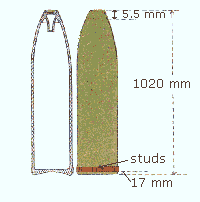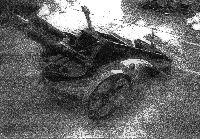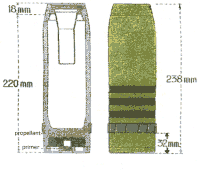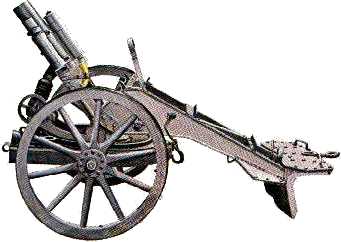|
Home History index
previous |
index |
next
| German Mortars (Minenwerfer) of WW1 |
| from "The Mortar" by WL Ruffell | |
Unlike the British and French the Germans were prepared to some extent for the trench warfare which began towards the end of 1914 during World War 1. Having studied the action around Port Arthur during the Russo-Japanese War (1904-05) - and no doubt with an eye to the future - they had developed the 'minenwerfer' (mine thrower), a rifled mortar, manufacture of which commenced in 1908-09. By 1914 160 of 25-cm (9.8-inch) calibre were available. See Fig. 18.

German 25-cm minenwerfer in action
Weight: 519 kg (1362 lbs)
Range: 200-560 metres
Detachment: 21
Rate of fire: 3 rpm
Elevation: 47°-74°
NB: The 21 in the detachment were required to haul and manhandle the
equipment into action.
Long HE shell for 25-cm minenwerfer. Note studs on driving band.
|

Figure 18
|
In addition to the 25-cm version two others of 7.6-cm (2.99-inch) and 17-cm (6.7-inch) were later produced. Except for size all three were similar in construction.
The 25-cm minenwerfer was a rifled muzzle-loading mortar firing a shell with a pre-engraved driving band. A short shell was at first employed but by 1917 had become obsolete. A longer HE shell was adopted as shown in Fig. 18A. The shell was described in a 1918 publication by the British Army as having 'great moral and destructive effect due to concussion even against troops in dugouts ...'. Also, it could clear a space 33 feet (10 m) or more in diameter in a barbed wire entanglement. While others fired other types of shell, e.g. smoke and gas, the 25-cm seems to have been restricted to HE. Propellant charges were first dropped down the barrel, then the base of the shell inserted in the muzzle so the driving band fitted the rifling and slid down to the breech. Ignition of the propellant charge was by friction tube.
All three minenwerfer were mobile with the wheels being removed on coming into action.
In 1916 a heavier version of the 25-cm minenwerfer was produced weighing 770 kg (1693 lbs) which fired the longer (94 kg) projectile up to 1000 metres (1094 yards).
The 7.6-cm minenwerfer, shown in Fig. 19A differed from both the 25-cm and 17-cm in its ammunition and method of firing. The projectile was fitted with a pre-engraved driving band like the heavy types, but unlike them also carried the propellant charge and means of ignition in a cavity in its base as in Fig. 19B. This feature was possibly copied from the Stokes.
German 7.6-cm minenwerfer.
Army Memorial Museum, Waiouru, New Zealand.
Weight in action: 100 kg (220 lbs)
Rate of fire: 20 rpm
Range: 300-1000 m (328-1094 yds)
Elevation: 45°-74°
Number of propellant charges: 5
Number of grooves in rifling: 6
Number in detachment: 6, who towed the mortar by dragropes.
|
 |
| Standard HE shell, showing method of firing |

Figure 19
|
As the barrel was extremely short, and the rifling would not permit the shell to be dropped with force sufficient to fire the primary cartridge, a simple firing mechanism was provided in the breech for that purpose.
Projectiles included HE, gas, and a special message shell designed to burst in the air over the addressee's position when all other means of delivering it had failed.
A heavier version was produced in 1916 weighing 142 kg (312 lbs) with a maximum range of 1300 m (1422 yards). With the advent of tanks in 1917 some minenwerfer were modified to fire horizontally. As a short-range piece of trench artillery the minenwerfer was very efficient and was widely used throughout World War 1.

Light Minenerfer on flat trajectory carriage for mobile use. Max. range: 955 yards. Weight in action: 550 lbs.
Return to top
previous |
index |
next
History index |
Home |
Wally Ruffell
|